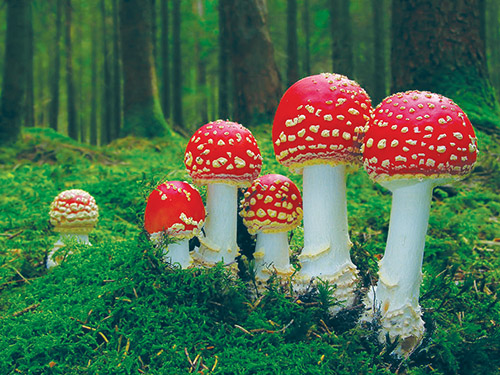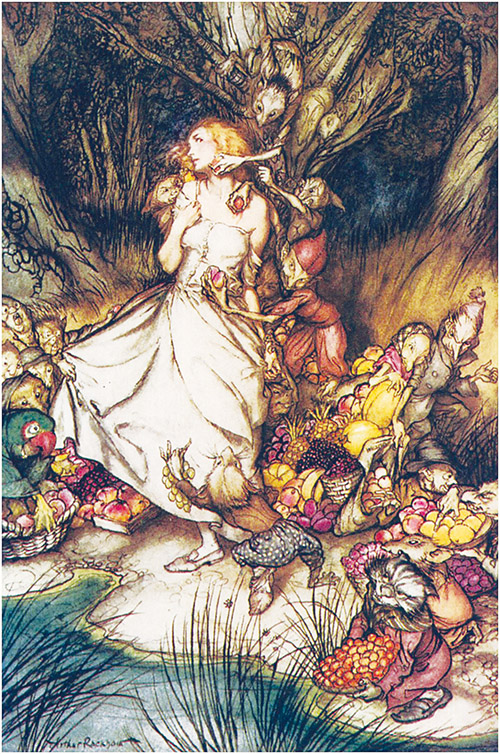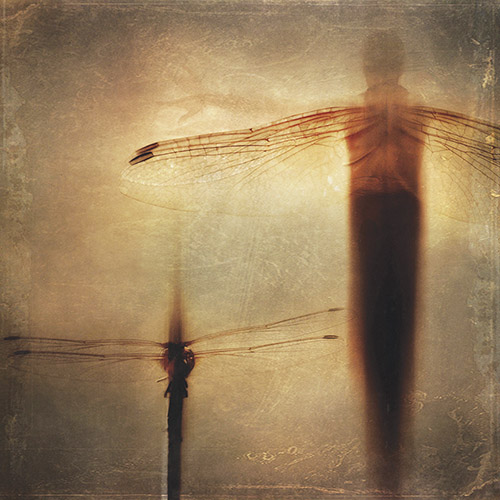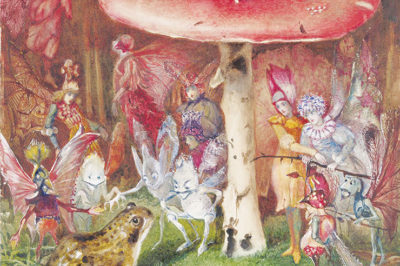From New Dawn Special Issue Vol 12 No 5 (Oct 2018)
What are the faeries? Where do they come from and where do they go when they’re not interacting with their human observers? Faeries have been an important part of the folkloric repertoire for hundreds (perhaps even thousands) of years, and while they are portrayed in the popular imagination through faerie-tales and have become disneyfied through the 20th century, their main presence is in the myriad of folktales and anecdotes from every part of the globe.1
They usually (though not always) take a humanoid form, and interact with human societies as ambivalent supernatural entities, appearing in our world to both co-operate with people and as general arbiters of mischief, while also living in their own Otherworld, sometimes accessible to humans either through accident or abduction. While the phenomenon is ancient, the belief in these metaphysical beings continues, and there are thousands of encounter reports from all over the world every year, as demonstrated in a recent survey by The Fairy Investigation Society.2
Folklorists are usually ambivalent about the faeries; they are likely to keep their distance from them, so to speak. While happy to record and discuss the beliefs of people who tell stories and anecdotes about them, most folklorists speak the language (at least in official publications) of the reductionist, materialist worldview that has held sway in Western civilisation for the last few hundred years, and they’ll be nervous about assessing the potential actual reality of metaphysical beings. In the materialist’s world, faeries simply cannot exist. They must be reduced into a categorised cultural belief system, and any discussion of them will usually be couched in the accepted language of scientific rationalism. This creates a problem for any folklorist (or anybody else) who wants to look behind the stories and investigate the possibility that the faeries can be incorporated into our consensus reality as a genuine phenomenon.
The scientific orthodoxy has been challenged recently by a range of philosophical hypotheses such as Idealism, backed up by quantum mechanical theory and experiment, which reinstates consciousness (not matter) as the primary mover and creator of reality.3 When this is done, entities such as faeries are allowed back into the universe as an authentic phenomenon, and if we start to look in the right places, we begin to find that they are indeed everywhere… we just need to know where to look, or more accurately, how to look.
The Electromagnetic Spectrum, Dark Matter and Dark Energy
Our normal waking consciousness experiences less than 1% of the entire electromagnetic spectrum. If we take into account the current (mainstream) scientific hypothesis that this electromagnetic spectrum itself composes less than 6% of the universe, with the mysterious Dark Matter and Dark Energy taking up the rest, then we are at a good starting point to understand that our version of reality is extremely compromised.4
We may have the technology to utilise the unseen wavelengths in the spectrum, but they are not accessible to our ordinary consciousness. Dark Matter and Dark Energy are entirely inaccessible to our technology, and remain for the moment nothing more than theory based on the by-product of mathematical equations.
We also have to take into account the recent theoretical mind-bender that the universe may actually be a Matrix-like virtual reality hologram, put in place by (depending on who you listen to) a supreme being, aliens or future versions of humans, the latter option coming from ex-NASA scientist Dr Rich Terrile.5
With this level of uncertainty about the reality we inhabit, and in order to gain an understanding of the world in which we live (and the unseen entities that may exist alongside us), we might be advised to fall back on the only known certainty allowed us: consciousness.
The Origins of the Faeries in Altered States of Consciousness
Our earliest known artistic portrayals of the world, and how human consciousness interacted with it, come in the form of cave paintings from all parts of the globe, starting c.35,000 BCE. Many of these cave paintings include humanoids and therianthropes, otherworldly entities that have been recorded alongside geometric imagery, stylised animals and landscapes. They are in effect our earliest known folklore. What state of mind were our Palaeolithic ancestors in when they were painting these strange entities in often difficult to access caves and shelters?
The anthropologist David Lewis-Williams has made the convincing argument that these cave and rock-shelter paintings were produced by shamanic cultures to represent reality as perceived in an altered state of consciousness.6 Twenty years ago this idea was anathema to anthropologists, but since the work of Lewis-Williams, and many others, the theory has tipped over to become an accepted orthodoxy. There are hundreds of motifs in the cave paintings that correlate with the visionary states of people in an altered state of consciousness, brought about most especially by the ingestion of a psychotropic substance. The basic premise is that the shamans of these Palaeolithic cultures transported themselves into altered states of consciousness and then painted the results of their experiences on the walls of caves and rock shelters – experiences that frequently included therianthropic beings and supernatural humanoids that correlate in many ways with later faerie types.
In his 2005 book Supernatural, Graham Hancock vividly utilises Lewis-Williams’ work to discuss the continuity through time of entities experienced in altered states of consciousness, coming to the conclusion that the faeries of our historic period are one and the same as those portrayed in prehistoric caves.7 And writers such as Carlo Ginzburg and Emma Wilby have argued that there is a direct link between prehistoric shamanic storytelling and the folklore embodied in classical, medieval and later periods, that often incorporate entities such as nymphs and faeries; supernatural beings that interact with humanity when the conditions are right.8 Those conditions may well be reliant on the human participants undergoing an altered state of consciousness as a result of the ingestion of psychotropic compounds. There is certainly a preponderance of mushroom imagery associated to historical depictions of faeries, most especially the highly psychedelic red and white Amanita Muscaria (fly agaric) mushroom, and the psilocybin mushroom, both prevalent in Europe and Asia. If these historic folkloric manifestations of interactions with supernatural entities can be linked to the cave art of prehistory and preliterate societies, then we have a continuation of relationship with an alternative reality, accessed through altered states of consciousness, over a very long period of time.

Many of the European faerie motifs repeated in stories and anecdotes through the centuries to the present day were already in place during the medieval period. When folklorists began to collect these stories in earnest from the 19th century onwards, they found a belief in faeries amongst rural populations that was probably very close to the medieval belief and understanding of what faeries were and how they interacted with humanity. Many of the stories include situations where the protagonist interacts with the faeries in what seems an altered state of consciousness: Faerieland doesn’t comply to Newtonian physics, it is consistently inhabited by strange humanoids and therianthropes (the faeries), and there are lots of recurring story motifs that are highly suggestive of an autonomous reality being described.
This is not consensus reality – this is the folklore recording stories from people operating outside consensus reality. The folktales about faeries have been overlain with much allegorical storytelling, but at their root the realities they describe are of people in altered states of consciousness, perhaps not too far from the realities experienced by the Palaeolithic cave painters and our shamanic ancestors.
WY Evans-Wentz, Rudolph Steiner & Metaphysical Nature Spirits
When the folklorist WY Evans-Wentz travelled around the Celtic world at the beginning of the 20th century, collecting stories and anecdotal experiences about the faeries, it was clear that most of his interviewees rated clairvoyance as the best way of altering the conscious state to a position where it could interact with the faeries.9 Seership or second-sight was the method of entering, or at least viewing, an alternative reality inhabited by a relatively consistent cast of characters, usually recognised as the faeries.
He met one such (un-named) Irish clairvoyant in Rosses Point, County Sligo. This seer talked about various types of faeries that inhabited the landscape of Sligo, “making them sound like a cross between nature spirits and mystical visions.” But Evans-Wentz was just as interested in the mechanics of interacting with the faeries as he was with the stories themselves. How did the seer interface with them?
I have always made a distinction between pictures seen in the memory of nature and visions of actual beings now existing in the inner world. We can make the same distinction in our world: I may close my eyes and see you as a vivid picture in memory, or I may look at you with my physical eyes and see your actual image. In seeing these beings of which I speak, the physical eyes may be open or closed: mystical beings in their own world and nature are never seen with the physical eyes.10
The rural people interviewed by Evans-Wentz consistently affirmed that clairvoyant alteration of consciousness was the best sure-fire way to see the faeries. By the time Evans-Wentz visited these communities, there was a sense that the number of people gifted with second-sight was dwindling; cutting down on communication with the faeries.

At the same time these rural communities were feeling the increasing pressures of modernism there was a reaction by organisations such as the Theosophical Society and the Anthroposophical Society to incorporate metaphysics into an understanding of reality. And their prime metaphysical technology was clairvoyance. The Austrian philosopher and esotericist Rudolf Steiner attempted to explain the mechanics of clairvoyance, when a person must transform their usually passive thought forms into something more dynamic. In normal consciousness, thoughts:
…allow themselves to be connected and separated, to be formed and then dismissed. This life of thought must develop in the elemental world a step further. There a person is not in a position to deal with thoughts that are passive. If someone really succeeds in entering the world with his clairvoyant soul, it seems as though his thoughts were not things over which he has any command; they are living beings… You thrust your consciousness into a place, it seems, where you do not find thoughts that are like those in the physical world, but where they are living beings.11
Steiner described the specific elemental animating forces at work in the natural world, when perceived clairvoyantly, in what he calls the Supersensible World. For Steiner the elementals in the Supersensible World existed as a range of beings, from devas, which are responsible for entire autonomous landscapes, through to the smaller nature spirits charged with the growth of vegetation.
Steiner (basing his epistemology on that originally developed by the 15th-century alchemist Paracelsus) divides these entities into four main types corresponding to earth (Gnomic), water (Undines), air (Sylphs) and heat/light (Salamanders). This is the faerie realm, existing as a non-material autonomous reality that crosses over with ours, and which can be accessed via a clairvoyant altered state of consciousness. Steiner thought everyone has this innate ability, but they had to be taught how to use it… it had somehow become almost forgotten amongst humanity.
This idea finds common ground with the recent work of biochemist Rupert Sheldrake, who proposes that morphogenetic fields are the formative causation allowing life on earth.12 Sheldrake’s description of this organising principle behind the natural world is issued in the language of biochemistry, but what he postulates is basically the same as Steiner’s vision of nature spirits in action. There are invisible forces that are as essential in ordering life on earth as accepted non-material forces such as gravity. Sheldrake calls these morphogenetic fields “the memory of nature.” In effect, Steiner saw nature spirits as anthropogenic representations of these morphogenetic fields, imposed upon them through the thought forms of the observer, who perceives them clairvoyantly.
The Faeries & DMT
What allows this access to otherworldly realms and the entities that seem to exist there? The answer may lie with the substance called Dimethyltryptamine – DMT. This molecule is one of the main active ingredients in the Ayahuasca brew used by Amazonian shamans, but it is also produced endogenously in everyone’s brain, potentially (but not definitely) in the pineal gland. It’s usually safely dispersed around the brain and body for functional duties, but it seems that under certain circumstances it can be released in higher quantities, causing an altered state of consciousness. There is some evidence that this can happen during a frontal lobe epileptic seizure, as recorded in the well-documented 17th-century Cornish story of Anne Jefferies’ abduction by diminutive faeries when she suffered a ‘convulsion fit’ and was transported (at least in her mind) to a numinous world inhabited by the faeries.13 The author Eve LaPlante has used historical and contemporary examples to demonstrate that Temporal Lobe Epilepsy can provide access to an altered state of consciousness where the human mind participates in a reality several steps removed from the consensus material world. This often includes full immersion in alternative landscapes and contact with non-human intelligence.14
The late and great Terence McKenna was an enthusiastic user of the synthesised form of DMT to access different realities and coined the term “self-transforming machine elves” for the creatures he regularly found there. As if to confirm Terence’s assertions, a research study conducted between 1990 and 1995 in the General Clinical Research Center of the University of New Mexico Hospital by Dr Rick Strassman found that volunteers in the study injected with varying amounts of DMT underwent profound alterations of consciousness.15 This involved immediate cessation of normal consciousness and transportation to a different realm of reality with divergent physical properties, and inhabited by a range of creatures described as elves, faeries, lizards, reptiles, insects, aliens, clowns (yes, clowns) and various therianthropic entities. One woman even describes a pulsating entity that she called ‘Tinkerbell-like’. The experiences, especially at higher doses, represented to the participants a parallel reality that was ‘super real’, not a hallucination, not a dream, but a substantial built reality with full sensory interaction plus telepathy.
The experience reports from the study are irrational, absurd, frightening, illogical and surreal. There is no question of any of the volunteers physically leaving the hospital bed during their experiences, but for all of them (without exception) the DMT-world was every bit as real as the one their minds left behind. After the injections participants frequently talked about ‘blasting through’ or ‘breaking through a barrier’ after which they found themselves in a realm with its own laws of physical space and movement, and its own inhabitants.
There are dozens of recorded experiences from the study, and the participants are all engaging in a non-physical reality directly with their consciousness, seemingly separated from their physical selfs. Some of the experiences agree in type to certain aspects of the faerie phenomenon. But what the research demonstrates is that under the right conditions, human consciousness can operate within a distinct and separate universe inhabited by a range of apparently autonomous entities [For more on this, see Peter Meyer’s article ‘An Ecology of Souls’ on page 23]. These entities may be one and the same as the metaphysical beings recorded in prehistoric cave art and historic folklore, by people who were describing the beings encountered during various types of altered states of consciousness, brought on either actively or passively.
The faeries may change superficially through time, adapting to the expectations of the culture they are part of, but if it is human consciousness they are interacting with, this is no surprise. Underneath the cultural masks, the faeries begin to reveal their true selfs.

Materialism vs Consciousness
There are many reasons why folklore about the faeries exists, and it certainly seems that interacting with them during an altered state of consciousness is one of them. Are they real experiences? They are subjectively real, but what is the objective reality?
A clairvoyant may suggest that we need to override our five senses with a dynamic type of consciousness that commands prominence over the material world. They would probably agree with Aldous Huxley’s description of a universal consciousness being “Mind at Large” and that the brain is a “reducing valve transceiver,” that can be retuned by a variety of methods. Huxley did this with Mescaline and LSD.16
The brain certainly gives us a very limited view of what is actually going on around us. Altering the transmission to the brain seems to allow non-material consciousness more of a free rein. As in a dream, an altered consciousness is able to construct metaphysical realities. It can communicate with the entities it finds there, and bring back a report. The relative consistency of the inhabitants of this alternative reality may suggest that they live there all the time, non-physical, and only able to interact with our physical world when conditions are right for an individual’s consciousness.
This is the crux: does consciousness create physical reality, or is consciousness an epiphenomenon of the brain? If the former, then the realities experienced in altered states of consciousness can be accepted as true, with their own autonomous existence. If the latter, then while entities such as the faeries may be subjectively real, they do not exist objectively within the visible electromagnetic spectrum. This is the materialist/physicalist view. Although even physicalism has to adhere to its own rules and allow for the hypothesis that well over 90% of the universe consists of non-physical form: Dark Matter and Dark Energy. Maybe that’s where the faeries are, waiting to be found.
Footnotes
1. The best introduction to faerie ontology is Katherine Briggs, An Encyclopaedia of Fairies (1976). There are dynamic illustrations (based on Briggs’ book) in Brian Froud and Alan Lee, Faeries (1978)
4. science.nasa.gov/astrophysics/focus-areas/what-is-dark-energy
5. in5d.com/we-are-living-in-a-hologram-designed-by-aliens-says-nasa-scientist/
6. David Lewis Williams, The Mind in the Cave: Consciousness and the Origins of Art (2002)
7. Graham Hancock, Supernatural (2005)
8. Carlo Ginzburg, Ecstasies: Deciphering the Witches’ Sabbath (1991); Emma Wilby, Cunning Folk and Familiar Spirits: Shamanistic Visionary Traditions in Early Modern British Witchcraft and Magic (2005)
9. WY Evans-Wentz, The Fairy-Faith in Celtic Countries (1911), www.sacred-texts.com/neu/celt/ffcc/
10. Evans-Wentz, The Fairy-Faith, p. 60
11. Rudolf Steiner, Nature Spirits: Selected Lectures (1995). ‘Perception of the Elemental World’ (1913), p.177-78
12. Rupert Sheldrake, The Presence of the Past: Morphic Resonance and the Habits of Nature (1988)
13. deadbutdreaming.wordpress.com/2017/09/23/the-faerie-abduction-of-anne-jefferies/
14. Eve LaPlante, Seized: Temporal Lobe Epilepsy as a Medical, Historical, and Artistic Phenomenon (1993)
15. Rick Strassman, DMT: The Spirit Molecule (2001)
16. Aldous Huxley, The Doors of Perception (1954)
© New Dawn Magazine and the respective author.
For our reproduction notice, click here.


